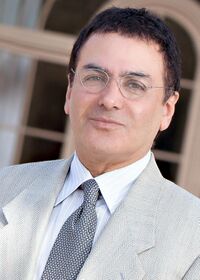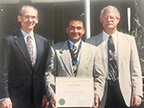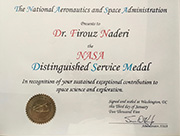Biography:Firouz Naderi
Firouz Michael Naderi | |
|---|---|
 | |
| Born | March 25, 1946 |
| Nationality | Iranian |
| Citizenship | United States |
| Alma mater | USC Iowa State University |
| Scientific career | |
| Fields | Space Science |
Firouz Michael Naderi (Persian: فیروز نادری: Fīrouz Nāderi; born 1946) is an Iranian scientist who spent more than 30 years in various technical and executive positions at NASA's Jet Propulsion Laboratory (JPL) where he contributed to some of America's most iconic robotic space missions. He retired from NASA in 2016 and currently is a management consultant, an advisor to early-stage high-tech startups, and a public speaker.
Early life and education
His elementary education was in Shiraz, Iran, where he was born. He attended high school in Tehran at an Italian boarding school (Don Bosco Boarding School) and left Iran in 1964 for the United States to pursue his college education. He received his undergraduate degree at Iowa State University before moving to California in 1969. After working as an engineer in Santa Barbara for two years, he enrolled at University of Southern California (USC) in Los Angeles where he received his M.S. in 1972 and his Ph.D. in 1976 both in electrical engineering. After completing his education, he went back to Iran for three years, working at the Iranian Remote Sensing Agency but returned to America in July 1979 after Iran's revolution. He has not returned to Iran since.
Career at NASA
He started at NASA's JPL in September 1979 as a communications system engineer, and in a course of a three-decade career rose through the ranks to senior executive positions. His career at JPL has spanned system engineering, technology development, program and project management for satellite communications systems, Earth remote sensing observatories, astrophysical observatories, and planetary systems.
His early work at JPL was on system design of large satellite-based systems for nationwide cellular phone coverage. He went to NASA Headquarters for two years in the mid-1980s to serve as the program manager for the Advanced Communications Technology Satellite (ACTS), the frontrunner of today's multi-beam, space-switching commercial satellites. Upon his return to JPL, he became the project manager for the NASA Scatterometer (NSCAT) project aimed at space-based radar measurement of winds over the global oceans with application to weather forecasting. He was awarded NASA's Outstanding Leadership Medal for his management of this project. Following NSCAT, in the mid-1990s he managed the Origins Program, NASA's ambitious, technology-rich plan, to search for Earth-like planets in other planetary systems.
Management of the Mars Program
He was named NASA's Program Manager for Mars exploration[1] in April 2000 after the agency had suffered two consecutive, very public failures in the previous year. In the summer of 2000, he helped re-plan the Program as a chain of scientifically, technologically and operationally interrelated missions with a spacecraft launched to Mars every two years. He led the Program for the next five years, a span of time that included the successful landing of the Mars Exploration Rovers, Spirit and Opportunity. All told, from 2000-2012 there has been an unprecedented 6 consecutive successful American missions to Mars (4 landers and 2 orbiters) based on the roadmap devised in the summer of 2000. For management of the Mars Program, he was awarded NASA's highest award, the NASA Distinguished Service Medal.
Before Mars, he managed the Origins program, NASA's ambitious technology-rich plan, to search for Earth-like planets in other planetary systems.
JPL's Associate Director
After the Mars Program, he was appointed JPL's first Associate Director for Project Formulation and Strategy,[2] serving as the Laboratory's senior official providing oversight of JPL new business acquisition and senior strategic planning officer. He created JPL's Innovation Foundry, an internal startup ecosystem akin to accelerator/incubator outfits in Silicon Valley. For six years, he managed an annual $100M internal investment fund for identifying and maturing nascent technologies, and mission concepts that showed potential to grow into funded space projects.
Director for Solar System Exploration
During his last five years at JPL, he was Director of Solar System Exploration[3] with responsibility for the Cassini spacecraft at Saturn, Dawn mission to Asteroids Vesta and Ceres, Juno mission to Jupiter, and formulation of the first ever Mars helicopter, and a multibillion-dollar mission to Europa (a moon of Jupiter) in search of life outside of Earth.
Asteroid Naderi
After 36 years, he retired from NASA in February 2016. At a farewell party in his honor, it was announced that Asteroid 1989 EL1 was renamed Asteroid "5515 Naderi"[4] for his contribution to space exploration. The asteroid was discovered by the late American astronomer, Eleanor F. Helin, at the Palomar Observatory in San Diego County, California, on March 5, 1989, and is about 10 kilometers (6 miles) in diameter. It rotates about itself every 5.2 hours and orbits the Sun every 4.4 years. "Fortunately, it is not an Earth-crosser," says Naderi.
Life after NASA
In his post-NASA career, he serves as a management consultant, an advisor to early-stage high-tech startups, and a public speaker. He also serves as a coach and mentor to the next generation of leaders within the Iranian-American community.
Public speaking
He is frequently invited as a keynote and motivational speaker at conferences and workshops. He has given talks to student associations at many universities, including Oxford, Stanford, Berkeley, MIT, UCLA, USC, Duke University, University of Toronto, Virginia Tech, University of British Columbia, University of California, San Diego, Texas A&M University, the University of Houston, and Karlsruhe Institute of Technology—Germany
Teaching
He has taught modules in executive education classes at Stanford on "Management of Large Complex Programs."
Philanthropy and community support
He is active advocate for the Iranian-American diaspora formerly having served on the board of directors of Public Affair Alliance of Iranian Americans (PAAIA).[5] He also sits on the advisory boards of several philanthropic organizations, including Keep Children in School Foundation (KCIS), International Society of Children with Cancer (ISCC), and is a former board member of Iranica Encyclopedia.
Famous quote
When asked that after living 50 years in America, does he feel more American or Persian, he said
Being Persian is part of my history and being an American is part of my identity and the two are irretrievably intermixed--like an egg that once scrambled, you cannot separate the yolk from the white. America is my country, and Iran is my homeland. And how blessed I am to be rooted in an ancient civilization with a rich culture, and at the same time a proud American living in this young nation that has lifted me on her shoulders, allowing me to reach for the stars.
Political affiliation
He is a registered Democrat and socially liberal, having voted for Bernie Sanders in the 2016 election. His views on the political system in Iran is that the people living in Iran should decide what is the best system of government for them. But, he favors a democratically-elected, secular government, observing full civil liberties and human rights with separation of "church" and state. He himself has no religious affiliation. However, in an interview in 2011, he called himself a "spiritual" person, believing in "something" beyond himself but not within the framework of any religion.[6]
Representing Iran at the 89th Academy Awards
He and Anousheh Ansari represented Iranian filmmaker Asghar Farhadi at the 89th Academy Awards for its winning in the Best Foreign Language Film category. Because of Farhadi's absence due to president Trump's immigration ban over seven Muslim countries including Iran; Farhadi selected Naderi and Ansari as his representatives at the Oscars, given that both of them are successful Iranian-Americans who immigrated to the US. On February 26, 2017, they accepted the Academy Award for Best Foreign Language Film for The Salesman on Farhadi's behalf.[7]
Recognitions
- Asteroid 1989 EL1 renamed Asteroid "5515 Naderi" (2016)
- NASA's Outstanding Leadership Medal
- NASA's highest award – the Distinguished Service Medal
- Ellis Island Medal of Honor (2005)
- Fellow of the American Institute of Aeronautics and Astronautics (AIAA)[8]
- American Astronautical Society (AAS) William Randolph Lovelace II Award (2010)[9]
- The Engineers Council's Theodore von Kármán Award (2007)[10]
- Space Technology Hall of Fame Medal (1997)[11]
- "Great Immigrants: The Pride of America" by Carnegie Corporation of New York (2015)[12]
References
- ↑ "JPL Names Naderi as New Head of Mars Program Office". https://www.jpl.nasa.gov/news/news.php?feature=4944.
- ↑ "JPL's New Associate Director Led Successful Mars Exploration". https://www.jpl.nasa.gov/news/news.php?feature=740.
- ↑ "News | JPL Announces Personnel Appointments". 2016-04-04. Archived from the original on 2016-04-04. https://web.archive.org/web/20160404231245/http://www.jpl.nasa.gov/news/news.php?release=2011-219.
- ↑ "List of minor planets: 5001–6000" (in en). Wikipedia. 2017-03-30. https://en.wikipedia.org/wiki/List_of_minor_planets:_5001–6000#515.
- ↑ "PAAIA Board Elects New Chair and Vice Chair" (in en-US). Paaia. 2011-02-03. http://paaia.org/CMS/paaia-board-elects-new-chair-and-vice-chair.aspx.
- ↑ Parazit پارازیت (2011-07-30), نسخه طولانی تر مصاحبه با فیروز نادری در پارازیت, https://www.youtube.com/watch?v=ExH7_JmVDRw, retrieved 2017-06-26
- ↑ Asghar Farhadi Will Be Represented By 2 Iranian-American Space Experts at the Oscars. Time (magazine) . Retrieved 28 February 2017.
- ↑ "Professional Society Fellows" (in en). https://scienceandtechnology.jpl.nasa.gov/community/professional-society-fellows.
- ↑ "William Randolph Lovelace II Award" (in en-US). American Astronautical Society. http://astronautical.org/awards/retired/lovelace/.
- ↑ https://www.jpl.nasa.gov/universe/archive/un0703.pdf
- ↑ "Advanced Communications Technology". https://www.spacefoundation.org/programs/space-technology-hall-fame/inducted-technologies/advanced-communications-technology.
- ↑ https://www.jpl.nasa.gov/universe/archive/universe1507.pdf
External links



